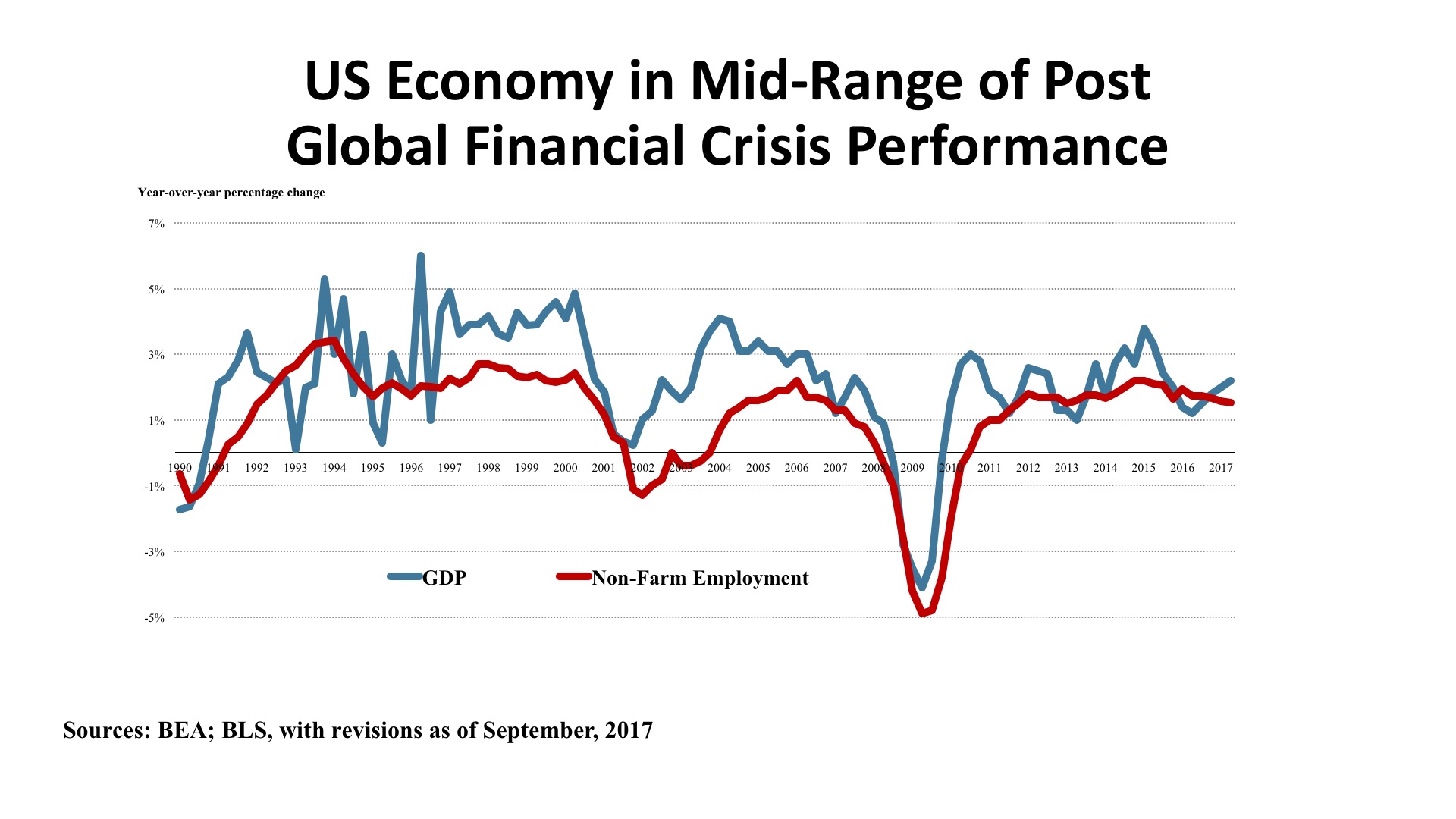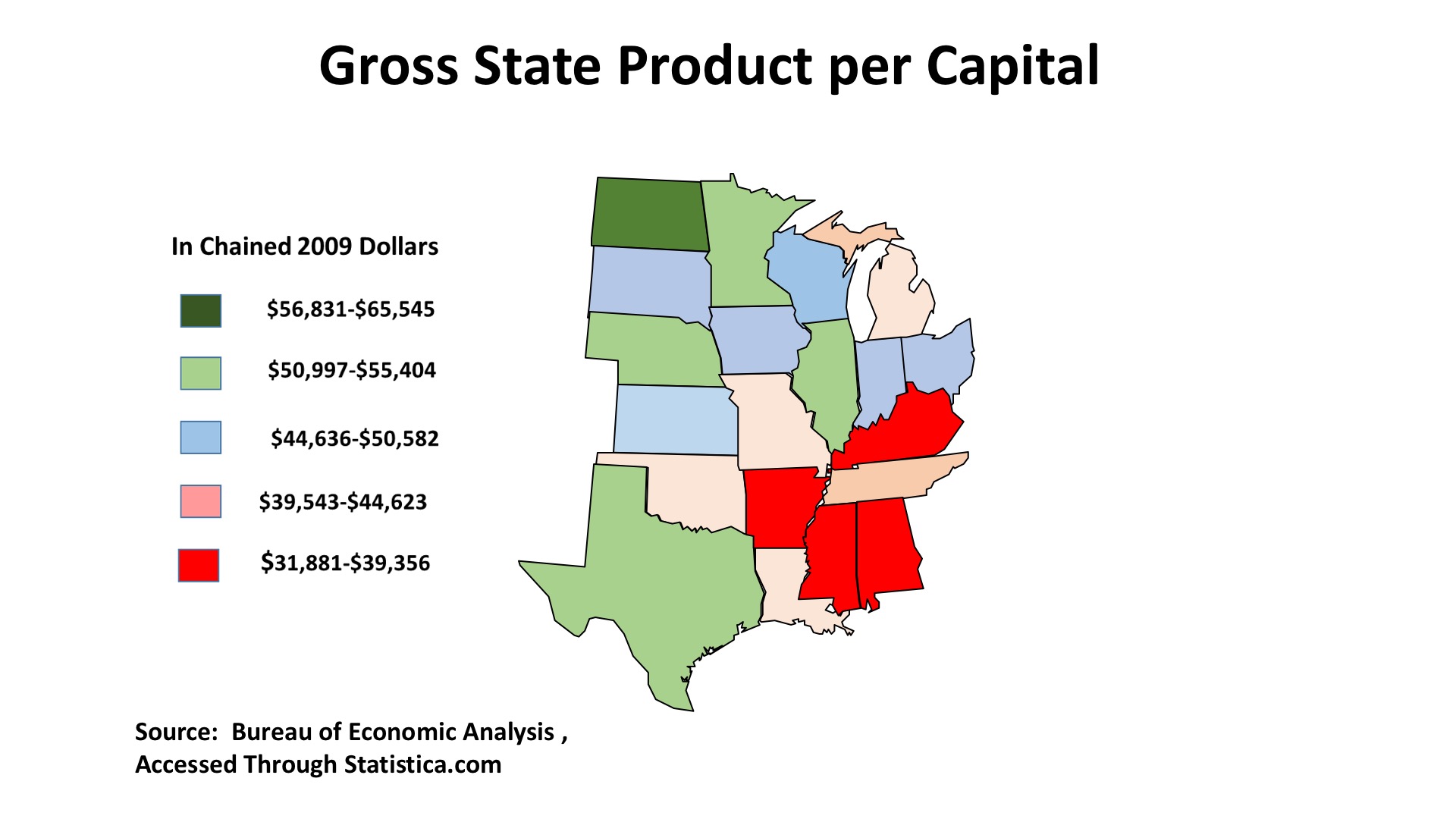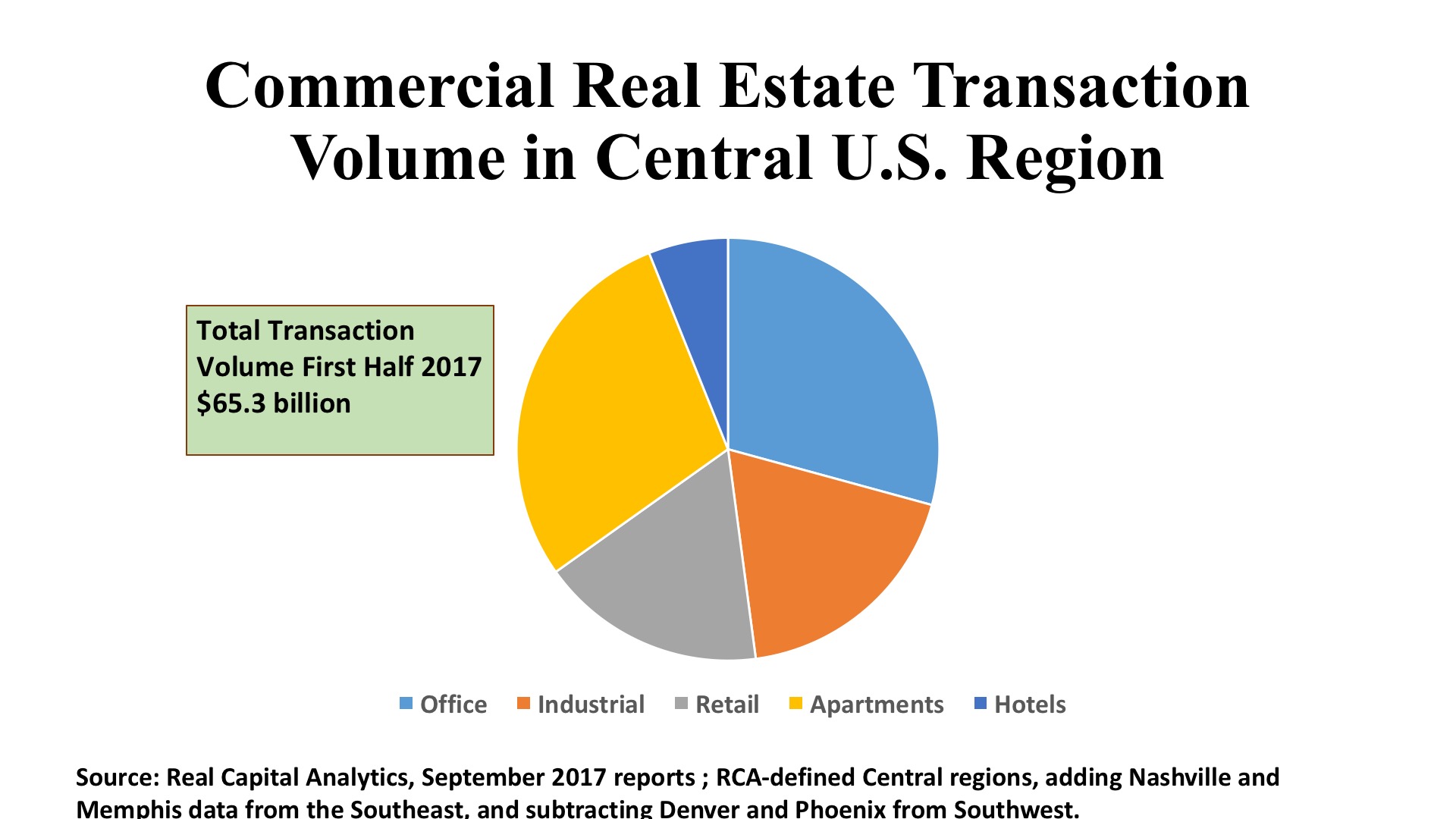National and Macroeconomic Overview

Natural catastrophes, including a devastating series of hurricanes and an intense wildfire season in the Western United States, have stressed many regions of the country during the third quarter of 2017. Nevertheless, the economy has thus far held steady within the moderate bounds of growth that have typified the recovery from the Global Financial Crisis of a decade ago. Although short-term impacts of the storms and fires will make headlines, the economy is large and resilient. It should sustain momentum with year-over-year GDP growth of 2.0% - 2.5% for both the remainder of 2017 and through 2018.
Mixed signals typify the reports from key economic sectors. Consumption, which represents about 70 percent of the U.S. economy, had a second quarter uptick as it did a year ago. In 2016, second quarter personal consumption grew at an annualized rate of 3.8 percent (up from 1.8 percent in the first quarter). This year, second quarter spending hit 3.3 percent (up from first quarter’s 1.9 percent). This pattern of a weak first quarter has frequently been seen since 2010. Existing home sales are running at 5.35 million, up just 0.2% year over year, the median home price is up 5.6 percent from a year ago. An increasing trade deficit acts as a depressant on GDP growth, and while real exports have been up 1.9% (as of August), real imports expanded more quickly at 2.8 percent.
Jobs. Nate Silver’s popular book on interpreting statistical data, The Signal and the Noise, cautions against the tendency to take one or two bits of information and extrapolating them into a presumed “trend.” So we shouldn’t make too much of the September employment report that tallied a 33,000 job loss, the first after 83 consecutive months of gains. Hurricanes Harvey and Irma impacted the market as the Bureau of Labor Statistics were collecting the September numbers, and when the October figures for U.S. Caribbean territories come in there will be an added effect measured. But recovery efforts will, later on, bolster the job picture. That’s important for the on-the-scene workers, but statistically, it is economic “noise.”
The “signal”, however, should give us deeper concern. That is the true trend, and it is measured by the now two-year-old slowdown in job growth – even before the storm impacts. Employment growth from mid-2014 until October 2015 posted year-over-year gains of two to 2.3 percent. We have not seen two percent growth since then, and average 1.5 percent for the first half of 2017. So the trend is a slow but persistent attenuation of job gains.
As we have indicated before, this is a story of increasing labor shortage caused by age demography, technological change, and a slowdown of new immigrant workers. The BLS “JOLTS” report (Job Openings and Labor Turnover Survey) showed healthcare and social services openings up 71,000, but declines in manufacturing (17,000), education (51,000), and other services (95,000). Overall, through August, the annual new hires tallied 63.8 million workers, versus 61.7 job separations, for a net gain of 2.1 million. This has been enough to drop the official unemployment rate to 4.2 percent, as of September.
Policy. Thus far, deregulation by executive order and by agency implementation has been the principal policy tool put to effective use in the first year of the Trump administration. In this, Federal policy has aligned with Wall Street hopes and expectations, extending the post-election bump well into 2017 and driving the DJIA up to 22,871 as of October 13, 2017 – or 26.4 percent higher than a year prior.
This is in contrast to the difficulties of moving fiscal policy forward by means of legislation, where healthcare reform efforts floundered, tax code changes remain at a nascent stage, and infrastructure investment has been deferred without much comment. Perhaps the President’s comment on healthcare covers the legislative agenda generally: “Who knew it was so complicated?”
As has been the case for a decade now, it is at the Federal Reserve where policy has been most effective and most transparent. Looking at the “signal” rather than the “noise,” the Fed is on a slow but steady course of tightening monetary policy, by moving interest rates gradually upward (despite still languid inflation) and reducing the huge balance sheet of assets acquired during the Quantitative Easing programs. Feeling that the markets are well-served by predictability, the Fed has been clear that its intent is to maintain a path of incremental adjustment rather than drastic policy shifts.
Outlook. There has been little change in outlook since the last edition of the TCN newsletter was prepared in July. GDP growth will fluctuate from quarter to quarter but stay in the 2.0 to 2.5 percent range on a year-over-year basis. Some upward drift in interest rates can be expected, but many are tiring of the wait for higher rates and believe it will be more than a year before the ten-year Treasury yields three percent. For the first time in decades, we may see a “soft landing” to an economic cycle rather than a hard recession. Right now, it looks like geo-political risk rather than economic dislocation is the main threat on the horizon. One variable to watch, though, is the continued widening of the incomes gap, likely to be the factor with the greatest potential to destabilize the trend of moderate upward expansion we have recently enjoyed.
Regional Economic Conditions

A long-ago television commercial featured a laurel-browed goddess calling down a thunderbolt while intoning, “It’s not nice to fool with Mother Nature.” Powered by Gulf of Mexico waters that were 85 degrees (F.) off South Padre Island, Hurricane Harvey dropped 42 to 61 inches of rain on Southeast Texas and nearby Louisiana and triggered flash flooding in parts of Arkansas, Tennessee, and Kentucky. Over six days, the monster storm dropped an estimated 27 trillion gallons of rain along its path. The economic impact has been estimated at between $75 billion and $111 billion. For perspective, Superstorm Sandy (2012) triggered costs of $70 billion and Hurricane Katrina cost $160 billion (both in inflation-adjusted dollars). The lessons of those prior storms indicated that recovery is a matter of years, not weeks or months.
Rebuilding efforts in the South Central states will likely be pushing up construction labor demand, in the face of an already tight squeeze on the supply of such workers. That shortage is echoed elsewhere in the region, as employers find it difficult to hire at virtually all skill levels. Eleven of the 20 states in the Central region have unemployment rates less than 4.0 percent. Naturally, wage growth is ticking upward and is likely to continue on that path as workers gain more leverage. Interestingly, so-called “Rust Belt” states like Michigan, Indiana, and Wisconsin are included on the list of tight labor markets.
The Central region boasts some of the most affordable housing markets in the nation, certainly far less expensive than the major coastal cities. Homebuilding is proceeding at a moderate pace, though, as construction financing (as well the labor shortage) is braking development despite low-cost home financing. It is expected that storm-ravaged areas in the South will see an uptick in building as disaster-relief funds find there was to the region.
Stabilizing energy prices are helping many of the Central states, as shale and natural gas fields return to higher levels of activity. Comparatively few states in this region post higher-than-average GDP per capita – notably North Dakota’s energy fields, and the more diversified economies of Texas, Illinois, and Minnesota. The agricultural states, with the exception of Nebraska, have GDP per capita figures below the U.S. average of $50,577 (2016 figures). This economic measure is a key indicator for real estate values, as it is productivity (output per worker) that generates rent potential for residential and commercial properties.
Commercial Property Investment Trends

With total real estate transaction volume of $65.3 billion, or 29.7 percent of the US total during the First Half of 2017, the Central region ranked second to the Atlantic Seaboard, edging out the Western Region for the period. The Central states were particularly strong in the multifamily sector with $25.9 billion in investment, or a 36.2 percent share for this property type. But the area also punched above its weight in the industrial sector, where $10.4 billion in purchases were 33.6 percent of the national total. Interestingly, the economy of the upper Midwest – both the industrial states and the breadbaskets states – are providing the more solid base in gross state product per capita, with Texas’ very large population and diverse industry mix helping support its property markets.
Office. Houston and Dallas topped the Central states in office investment during the first six months of 2017, with Houston exceeding $2 billion in transactions and Dallas approaching $2.5 billion. At least in part, capital was attracted by above-average cap rates of nearly 7 percent, well above the yields available in the large cities of the East and West coasts. Chicago also saw more than $1.2 billion in office deals, with an average cap rate of 7.4 percent – a yield that was typical of other large Midwest cities. International investors are becoming more active in secondary markets such as Columbus and Cincinnati, while domestic institutions and private investors are devoting attention to Texas and the smaller metros of the South Central area.
Industrial. The Central states are naturally well-positioned for distribution facilities, and both Chicago and Dallas constitute major hubs of warehousing activity. Dallas was the location of 152 industrial property sales transactions in the First Half of 2017, with volume totaling more than $1.6 billion. Chicago, meanwhile, generated 155 transactions worth $1.5 billion. Cap rates averaged 7.3 percent in both metros, giving investors high initial yields and the prospect of steady returns. Institutional investors played a prominent role in both markets. Houston presents a similar profile, albeit at a lesser volume ($863 million during the First Half) – and the repair and recovery period following Hurricane Harvey is likely to keep volume in southeast Texas limited for a while. Elsewhere, smaller private investors are the majority of buyers, both in the secondary metro markets and in the third-tier locations which, in total, show more than 900 individual sales amounting to another two billion dollars of acquisitions.
Retail. This region tallied $9.5 billion in shopping property sales, 27.5 percent of total U.S. retail sales volume. The relatively low level of GDP per capita suggests why consumer spending is less than robust across much of the region. Of all the major cities, only Chicago saw retail property transactions rise above $1 billion, with 130 deals generating $1.5 billion. Dallas came in second, with 107 purchases amounting to $930 million in aggregate price. Retail cap rates average between the mid-six percent level for Chicago, Dallas, and Austin, to around seven percent for Minneapolis, San Antonio, and Houston, and rise to eight percent for the Ohio cities such as Cleveland and Columbus. Private investors are far and away the most common buyer type, contrasted with the concentration of REIT buyers in the Eastern region.